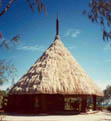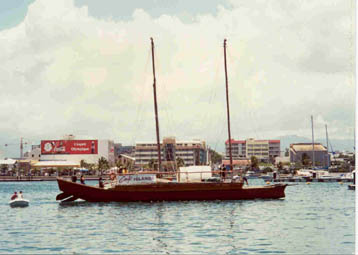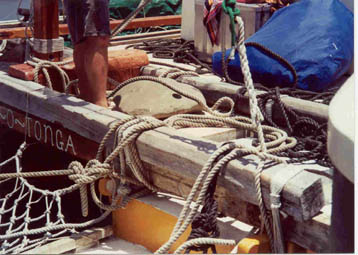
The Seafaring Tradition
For almost 2000 years the people of the Pacific have maintained the tradition of seafaring in canoes called Vaka (Waka to the New Zealand Maori). These sailors became great navigators using the stars, the winds, the currents, and the birds to make their way across great expanses of ocean. I have been told by friends from Peru and Chile that evidence of these ancient journeys is often found along the western coast of South America in the form of stone anchors.
The tradition continues today and several of the participating island nations send a contingent in a seafaring canoe. At each festival there is a ceramonial landing of the canoes, some of which have traveled great distances to get to their destination. Unfortunately, Hawaii was not able to participate in the 8th Festival due to economic difficulties. So the Hokulea, the largest Vaka in the Pacific, did not make the trip. The two large canoes to make the festival were "Te Au O Tonga" from the Cook Islands, and "Te Aurere" from New Zealand. Both of these vessels are what the Moari call "Waka Hourua", a seafaring, twin-hulled sailing vessel.
 The canoes landed on the beach at Anse Vata. |  Te Au O Tonga is seen in the background. |
 Thousands watch the landing. |  Modern fiberglass canoes were used by youth participants. |
 Upon landing they posed for pictures, danced and sang. |  Each of the canoes was decorated with plants and flowers. |
 Te Au O Tonga, the Cook Island Vaka |  Moana helps tie the Vaka down. |
 Not to miss out, Steffan assists as well. |  Note the stone anchor on the deck. |
Te Au O Tonga is a beautiful craft. Terry, one of the Cook Island sailors (who actually lives in Houston and is a wild animal tamer) told me that they sailed for 11 days and had to go adrift for three addtional days because they were caught in a storm. They left from Rarotonga, Cook Islands and traveled a distance of approximately 2300 miles crossing the International Date Line.
Te Aurere had difficulty arriving, needing to have supplies dropped by the Coast Guard while enroute. A cracked hull and unfavorable weather caused her to land on the Isle of the Pines rather than Noumea. As if pre-destined, Manamaky, where Te Aurere was beached, is the heart of Waka culture. Craftsmen on the island continue their canoe building tradition. We were told later that the people of Manamaky treated the crew like kings and taught them much about this ancient tradition. On its return trip, Moana met up with Te Aurere in the Norfolk Islands, and sailed back to New Zealand with the crew.
 Tito, the pilot. |  Me and Tito. |
 Libby applies sunblock on Steffan's back. |  Libby and Steffan enjoy the view. |
Libby, Steffan, and I took a ride on a local canoe piloted by a man named Tito. Tito dropped us off on a nearby island and returned for us a few hours later. He was a quiet man who humbly accepted a ham sandwich that I gave him, and delighted at also being christened an "Honorary Texan." The ride to and fro was beautiful. I am continually fascinated by the simple, yet highly effective technology that is used in building and operating these vessels.
 Libby, Steffan, and I were joined by a couple from Australia. They, however, did not stay on the small island, choosing to continue on with Tito. |
 The canoes are made with simple but effective technology. |